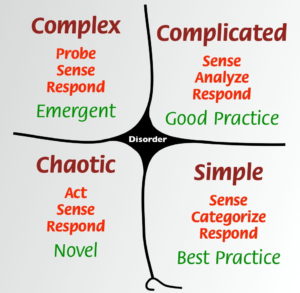The idea of “best practices” has always driven me a bit nuts. The world is full of complexity and context and interconnections, I figured. How could any “one way” or “single process” across many instances be “best”? In fact, how could it be anything more than a delusion? Sure, there are “fruitful paths” that seem to yield positive results in many cases. But “best practice”? Nope.
So, it’s a bit ironic that as I read about, work on, and wrestle with complexity theory, systems theory, and developmental theory, “best practice” is looking more legitimate. As it turns out, there are many instances where a specific recipe is “best” for a desired outcome. The trick is to know when you’re inside one of those instances (and when you’re not).
Consultant and conceptualist Dave Snowden has developed a rather handy framework to help individuals and groups determine the nature of their current environment. The framework suggests five decision-making contexts or “domains” — simple (or “obvious”), complicated, complex, chaotic, and disorder — each requiring a different approach to observation and response.
In short, those five contexts or domains are:
- Simple (more recently called Obvious)
Cause and effect are well understood by most competent managers, and “best practices” rule the day. - Complicated
Cause and effect exist, but are difficult to discern, requiring experts and higher-order analysis (CPA, CFO, consultant). There are many possible paths through (so no “best practice”). There is, however, “good practice,” which includes any of the paths that lead to productive results. - Complex
There’s no discernible cause and effect, but there are emergent patterns for those who watch closely. Here, you discover your path through small, safe-to-fail experiments which you can accelerate or dampen as you observe their outcomes. - Chaos
No cause and effect, no patterns, entirely random. If you go here on purpose, it’s for short, intentional bursts of innovation. More likely, you fall or stumble into this space by unexpected or unattended circumstance. Your best path here is to take immediate action to stabilize, make stuff up, improvise, and struggle your way into the complex space if you can. - Disorder
This is the domain where most of us live most of the time, when we don’t know which context we’re actually in.
To make matters a bit more, well, complicated, it’s quite likely that different aspects of your enterprise are in different domains. Your financial accounting and reporting system, for example, is likely in the Complicated domain, unless you’re a really small business, where it’s fairly obvious how you should track your expenses and income. Long-term strategy and enterprise development are likely in the Complex domain, where even experts can’t tell you what will work in the long run. Some activities are (mostly) Simple or Obvious, like systems or reminders to actually thank your donors in a timely way.
So yes, “best practices” can be “best” if the work at hand is simple or obvious to most of us, and cause-and-effect are identifiable and reliable. But in other circumstances “good practice,” “emergent practice,” or even entirely “novel practice” may be required.
If you’re interested, here’s a short video of Dave Snowden describing the framework, and helping you pronounce it (it’s a Welsh word).



Thanks. This was a very interesting and useful video.
Thank you, Andrew. This has me reviewing a half-century of experience in performing arts presenting. It all rings true, particularly the “cliff” between Simple and Chaotic. (In 2009, the entire industry fell off that one!)